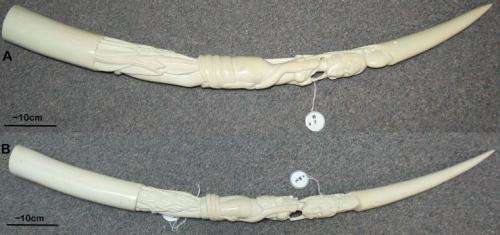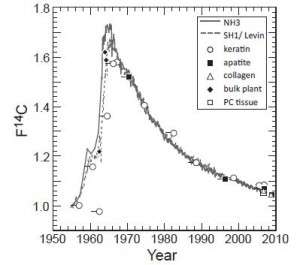Science nabs illegal ivory sellers

A Toronto-based company has been convicted of selling illegal ivory in the first case to use a technique for dating ivory developed by a scientist at the Lamont-Doherty Earth Observatory in collaboration with other colleagues.
Five Star Auctions and Appraisals, and its director, Mrs. Chun Al Jin, were charged after testing revealed two carved elephant tusks they were offering for sale had come from animals – possibly the same elephant—killed in late 1977 or early 1978. Under Canadian law, sellers must be able to prove ivory came from an animal taken from the wild before July 3, 1975, and that it was legally imported to Canada.
The case against the Toronto company is the first time that this dating technology has been used to obtain a conviction under wildlife law in Canada, and one of only a half dozen cases where radiocarbon dating has been successfully used worldwide, according to Environment Canada, a government agency.
A 1989 international agreement bans commercial trade in ivory, with exceptions, including ivory harvested before 1976. Yet the amount of poaching has increased in recent years: A 2014 study found that poachers had killed an estimated 100,000 elephants in Africa between 2010 and 2012 and blamed the slaughter on increased demand for ivory in China and other Asian nations. Last week, China banned imports of ivory carvings for one year. Critics contend that move will have little effect on the illicit trade and continuing slaughter of elephants.
It has been difficult for law enforcement agencies to differentiate old from new ivory. That changed when scientists developed a new technique to radiocarbon date ivory and other organic materials, allowing for precise dating.
The method was described in a 2013 study in the Proceedings of the National Academy of Sciences (and in an Earth Institute story). Lead author Kevin Uno, a postdoctoral researcher at Lamont-Doherty, said he got a call soon after from Todd Kish, a field officer with Environment Canada, who had read about the new technique in a magazine article.
"We hadn't been able to apply it to a real forensics case yet," Uno said. Then, "Todd called me … and said we just seized some tusks from an auction house, and do you want to try this out? They were trying to figure out how to nail these guys, and the only way to do it was to date the tusks."

But there was a snag: Under the Convention on International Trade in Endangered Species, it's illegal to send the tusks from Canada to the United States, even for scientific purposes, without undergoing a lengthy permit process. Uno's solution: Have a lab in Canada convert some of the collagen in the tusks into CO2 – basically by burning it. They then shipped the CO2 gas samples in small glass vials to the University of California-Irvine, which has one of a handful of labs in the world that can conduct radiocarbon testing. The results were definitive.
"You can't really argue with this. The facts are right there," Guillaume Labrecque, of the radiochronology laboratory at Quebec's Laval University, who helped conduct the analysis, told the Canadian Broadcasting Company.
A chart of the "bomb curve" used in dating the two illegal elephant tusks.A chart of the "bomb curve" used in dating the two illegal elephant tusks.
The vast tropical and temperate oceans, where most coral reefs grow, see the least variation, with pH hovering between 8.05 and 8.15 as temperatures fluctuate in winter and summer. Here, the waters are oversaturated with respect to the mineral aragonite—a substance that shell-building organisms need to thrive.
Ocean pH fluctuates most in the colder waters off Siberia and Alaska, the Pacific Northwest and Antarctica. In spring and summer, massive plankton blooms absorb carbon dioxide in the water, raising pH and causing seawater acidity to fall. In winter, the upwelling of CO2-rich water from the deep ocean causes surface waters to become more acidic. Acidification of the Arctic Ocean in winter causes aragonite levels to fall, slowing the growth of pteropods, planktic snails that feed many predator fish.
The maps reveal that the northern Indian Ocean is at least 10 percent more acidic than the Atlantic and Pacific oceans, which could be due to its unique geography. Cut off from the Arctic Ocean, the chemistry of the northern Indian Ocean is influenced by rivers draining the massive Eurasian continent as well as seasonal monsoon rains.
By analyzing long-term data collected off Iceland, Bermuda, the Canary Islands, Hawaii and the Drake Passage, off the southern tip of South America, Takahashi finds that waters as far north as Iceland and as far south as Antarctica are acidifying at the rate of 5 percent per decade. His estimate corresponds to the amount of CO2 humans are adding to the atmosphere, and is consistent with several recent estimates, including a 2014 study in the journal Oceanography led by Nicholas Bates, research director at the Bermuda Institute of Ocean Sciences.
"This is exactly what we'd expect based on how much CO2 we've been putting in the air," said Rik Wanninkhof, a Miami-based oceanographer with the National Oceanic and Atmospheric Administration (NOAA) who was not involved in the study. "This is an important point for scientists to underscore—these calculations are not magic."
If the current pace of ocean acidification continues, warm-water corals by 2050 could be living in waters 25 percent more acidic than they are today, said Takahashi. While corals can currently tolerate shifts that big, marine biologists wonder if they can sustain growth at lower pH levels year-round. "In the long run it is the average pH that corals see that matters to their ability to grow and build a coral reef," said Chris Langdon, a marine biologist at the University of Miami, who was not involved in the study.
Ocean acidification is already having an impact, especially in places where the seasonal upwelling of deep water has made seawater naturally more acidic. In a recent study by researchers at NOAA, more than half of the pteropods sampled off the coast of Washington, Oregon and California showed badly dissolved shells. Ocean acidification has been linked to fish losing their ability to sniff out predators, and the die-off of baby oysters in hatcheries off Washington and Oregon, where more acidic deep water comes to the surface each spring and summer.
By 2100, ocean acidification could cost the global economy $3 trillion a year in lost revenue from fishing, tourism and intangible ecosystem services, according to a recent United Nations report. The U.S. Government Accountability Office, the watchdog arm of Congress, has reached similar findings and recommended that President Obama create a research and monitoring program dedicated to ocean acidification.
More information: "Bomb-curve radiocarbon measurement of recent biologic tissues and applications to wildlife forensics and stable isotope (paleo)ecology." PNAS 2013 110 (29) 11736-11741; published ahead of print July 1, 2013, DOI: 10.1073/pnas.1302226110
"A Time-Series View of Changing Ocean Chemistry Due to Ocean Uptake of Anthropogenic CO2 and Ocean Acidification." 2014, Oceanography 27(1):126–141, dx.doi.org/10.5670/oceanog.2014.16
Journal information: Oceanography , Proceedings of the National Academy of Sciences
Provided by Columbia University





















